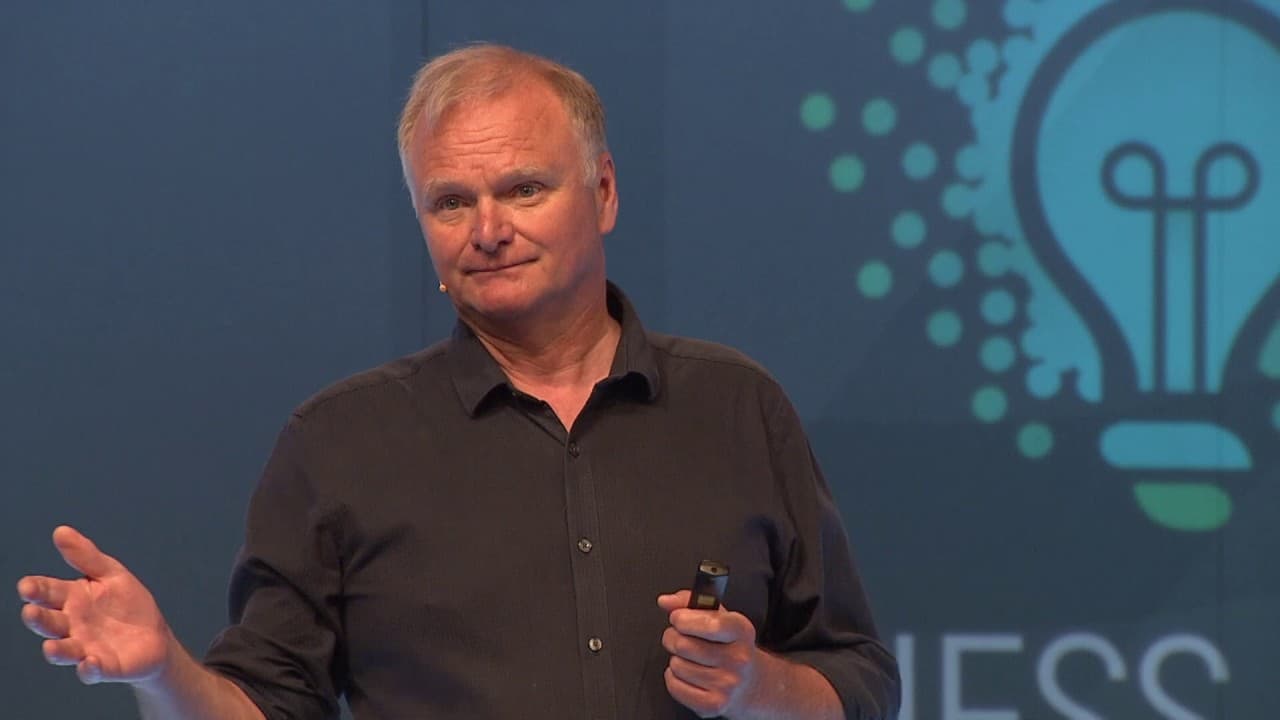Thank you. I hope you do that when I'm finished as well.
I could have told you a story today about business agility at Equinor, the company I work for, used to be called Statoil, how we implemented Beyond Budgeting. But that means that you need to understand what Beyond Budgeting is, and there is no time for both in 20 minutes. So I've decided to focus on what is Beyond Budgeting, and maybe we've got time to come back to later what that means in practice.
The one thing that finance people, executives, H.R. people and many others are afraid of, or what they are most afraid of when it comes to talking about business agility or management innovation, that is the fear of losing control. It keeps coming back all the time. And what does that mean, 'control'? If you go to the definition, it's about the power to influence or direct people's behavior or the course of events. What does that mean in business terms? That means controlling people and controlling the future. And this is where the illusions of control kick in, because traditional management is totally built on on these two illusions that people can, and must, be managed, and that the future is predictable or manageable. It is not true.
We are not alone in criticizing traditional management. I love this quote from Peter Drucker: "Most of what we call management is about making it difficult for people to do their job." I also like this quote from Russell Eckhoff talking about corporate planning, "Most corporate planning is like a ritual rain dance. It has no effect on the weather, but those who engage in it think it does. Much of the advice is directed at improving the dancing, and not the weather.", and trust me, I have done a lot of dancing in my life. I used to be a budget guy, my first management job, 1984, head of the corporate budget department. I know what I'm talking about.
This is all about performance. How do we get the best possible performance in organizations? And some of you know that I like to use traffic as a metaphor for what we are after, because in traffic, we would also like to see good performance. A safe and good flow. And this is something we often meet, put up by traffic authorities, to create that. Two questions: who is in control? Well, that's the guy who programmed this light, and by the way, there's no sensors, no high tech here. It's a programmed light, and the guy who programmed this, that is the manager. Where would this person be as you sit there waiting for the green light? Somewhere else. So here is a management model, which is not just based on somebody not being present, but they're also based on information that is not entirely fresh as you sit there waiting, right, because it's based on some historical trends, and so on and so on.
Fortunately, there is an alternative: the roundabout, same questions, very different answers. Who is in control here? Well, we are, as drivers. And based on which information? Based on fresh, realtime, here and now information, very different answers. So maybe we should compare a bit more these two ways of managing. A few leading questions for you. Which of these two is normally most efficient? It's been proven. Scientifically, normally, it is the roundabout. Which is most difficult to drive in? Of course, it's the roundabout, and going back to organizations, you all know that what we need to move towards, it takes more competence. It is more difficult than the stuff that we need to leave behind. Traditional management is very easy for everybody involved, managers, employees.
Last question here. Is it relevant to talk about values in this setting of traffic? In our company we talk a lot about 'values-based management'. We are very serious about it, and the opposite we can maybe call 'rules-based management' - a bit simplified. The traffic light is a good example of rules-based management. Red means stop, and green means drive. We can always discuss yellow, but beyond that, very simple rules-based system. And if there's a value set, a mindset among drivers waiting for that green light, which is about "me first, I don't care about the rest." That mindset is normally not a big problem in front of that light, but in the roundabout, "me first, don't care about the rest", is actually a big problem, because here we are much more dependent on, on interacting with people. We have to help each other. We need this shared, positive, common purpose of wish, of wanting this to flow well.
Words are important in this setting, and there are some words I don't like in the management vocabulary, one word is 'performance management'. I find it very negative, the notion that we need to manage people in order to get performance, and also I think there's quite a lot of illusion of control into that. But it is a label that definitely fits well when we talk about the traffic light. That's exactly what traffic authorities are doing, they are managing performance very directly. In the roundabout, it is actually about something else. That is more about creating conditions for great performance to take place. It is about enabling performance, and not managing performance. And this is more than playing with words. These are two very different ways of thinking about these important questions about how do we get the best possible performance in our organizations.
The roundabout is a more self-regulating way of managing, and I would argue, leaving traffic now, that in today's business realities and people realities, organizations need more self-regulating management models, and I know you agree with me because that's why you are here. And one reality we need to reflect on is the world out there, and with that level of VUCA out there, volatility, uncertainty, complexity, ambiguity, our management models need to look differently compared to in the old days when there was much less VUCA out there. But then we also need to look internally, at the organization, at our people, asking ourselves what kind of people do we generally believe that we have in our organizations?
And you are all familiar with Douglas MacGregor, Theory X and Theory Y, and we need to ask that question. Where do we think most employees sit? On the X side or on the Y side? And if we conclude that, 'I believe on the Y side', our management model should look very differently compared to if we believe that they mainly sit on the on the X side. By the way, this is not necessarily a question of either/or. I mean, it could be that there are some people in an organization that maybe, at least from the outside, look like they are more on the X side than on the Y side, that they have to be a little bit controlled and whatever. But that's not the issue. That's not the question. The question is, where is the majority? And if the majority is on the Y side, then we need to find other ways of dealing with these few cases on the X side. This is just like in a free society. We don't put everybody in jail because we have some criminals among us. We are all free citizens within certain boundaries.
So what we need to do is to address both leadership and management processes, and what we need to get out of. Traditional management: very rigid, detailed rules-based, micromanagement, centralized command and control, a lot of secrecy, and a strong belief in sticks and carrots as ways to drive performance. What is a bit scary, when I'm sharing this slide at different conferences out there, which is not about Agile, but it's about finance or management or H.R., all the looks I get when these words are coming up. All the looks telling me, isn't that the way it has to be? But it's quite scary. We might think it's stupid, but there's a lot of people out there who think that this makes sense. Maybe it did once, maybe it still does a few places, but I hope we can agree that that is not the place to be. We need to move up in that upper right hand corner addressing both leadership and management processes in a coherent, consistent way. This cannot be a discussion about leadership in isolation. It cannot be a discussion about management processes, in addition. It has to be a discussion that takes both dimensions into account, in a coherent, consistent way.
On the leadership side, more values-based, more autonomy, more transparency, and leaving the stupid belief that money is the best way to motivate performance. You know what the research is telling us. But it doesn't help to have these theory Y leadership visions if we have theory X management processes, and that is the case in a lot of organizations. They do preach nice words, maybe they even believe in nice words about people. But their management processes has a very different message, and that is a problem. So we need to change our management processes to better reflect what we say and believe about people, while at the same time making these management processes more VUCA robust.
So here are a few things that we need to do in this dimension. Very often the traditional detailed annual budget either has to go, or be significantly changed. And by the way, budget and Beyond Budgeting, yes, it is called Beyond Budgeting, but and and Beyond Budgeting is about much more than budgeting. But you will never achieve a true organizational Agile transformation without also addressing the budgeting process and the budgeting mindset. There's a lot of great concepts out there in the business agility sphere, but I think we are the only one who is talking about the elephant in the room, that process and that mindset. And linked to that, we need to think differently when we are setting goals and targets. We need to think more in relative terms, when it makes sense. Just like in football. No football team would say that our most important ambition for next season is to score 45 goals and get 49 points. Those are budget goals. We need - football don't think like that. They think in relative terms, how are we doing versus others.
We need to change the rhythm of our processes. We need a more business-driven, more events-driven rhythm, and less of a calendar-driven rhythm. January to December is very often a completely artificial period from, from a pure business point of view. And last but not least, when we shall evaluate performance, that cannot be reduced to comparing two numbers, actual versus budget, and then conclude. We need a richer, broader, more intelligent performance language. And this, my friends, was a crash course in Beyond Budgeting. This is what it is about. Changing, addressing both leadership and management processes in a coherent, consistent way in order to become more adaptive and more human. Not necessarily a goal in itself, but this is what it takes, as you all know, to compete and survive and thrive in today's business and people realities.
The Beyond Budgeting principles were born roughly at the same time as the Agile Manifesto came about. Actually, we were a few few years earlier. There was no knowledge, no contact between these communities at the time. But if you look at the next slide here, I hope you will see many similarities with the words and the spirit of the Agile manifesto.
The principles looked like this, I will not go through this in detail, but I want to share a few messages around, around this.
On the leadership side, purpose, values, transparency, autonomy. Very important things. Organization - we don't have a strong view on what's the right organizational model, we think this can work in many different structures. Structure is not necessarily the main issue.
On the management process side, you will find basically everything that a CEO or a CFO, or another executive person would be, what would be on their mind when it comes to managing a company. Everything from the rhythm, to how you set targets, how you forecast, how you allocate resources, and how you evaluate performance and how you reward performance. It's very comprehensive. Complete management model. And again, a key element here is the coherence between what we preach on the left hand side, what we practice on the right hand side. Two examples of the opposite that we find in so many organizations. It doesn't help that we on the left hand side talk loud and warm about "we" and "us" and "team" and "collaboration" when rewards is all about individual bonus. Hypocrisy, is what I call it. Or another classical example, it doesn't help that we talk equally loud and warm on the left hand side about how fantastic people we have in the organization, and we would be nothing without you, and we trust you so much. But not that much. Of course, we need detailed travel budgets, are you crazy? What would happen if we kicked out those? Again, hypocrisy. Doesn't help what we preach and write if our management processes has a different message.
One reason why it is like this has actually to do with Finance and H.R., because in many organizations you have H.R. preaching leadership principles, but it doesn't help if Finance is pushing management processes, which has the very opposite message. And in many organizations, that is the case because Finance and H.R. are very often like cats and dogs in organizations. They talk a lot about each other, not much with each other, and I know because I've been in both places, I am a finance guy, but I also worked in H.R.
So a strong advice we always give to organizations that want to embrace on a journey like this: Finance and H.R., you need to work together to enable business agility.
A classical misunderstanding around Beyond Budgeting is that it is just a different way of managing cost. Well, that is not a misunderstanding because it is. We need more - but it's just one of twelve principles. Principle ten is about cost management, but there are 11 other principles. By the way, when it comes to cost management, the reason we need something else than traditional budget theory, is that that is something that was invented as a way to manage resources and cost 100 years ago. It's a pretty old management technology we're talking about. And by the way, do you know who invented budgeting roughly 100 years ago? You do know his name, or you have heard that name? Because his name was James O. McKinsey, the founder of the founder of McKinsey Consulting, and I never met the guy, but I don't think that was an evil guy. I actually think it was the best of intentions back then. The purpose was to help organizations perform better. That was management innovation 100 years ago, and maybe it probably worked 100 years ago, maybe even 50 years ago. But today, that way of thinking that way of managing, does the opposite of that original intention. Instead of helping organizations perform better, it does the opposite. It has become a barrier for getting out the best possible performance in organizations.
This is Beyond Budgeting in a nutshell, and again, I hope you see the similarities with the Agile manifesto, responding to change or following your plan as one. And if you - so, a lot of all the similarities. And it is great that there is so much contact today between our communities, because I don't think none of us will succeed on our own. There are many other communities out there challenging traditional management, and the more we can join forces, the stronger we will be. And this stuff that we will talk about today, it will happen, it will happen. I don't care whether it's called, going to be called Beyond Budgeting or business agility or whatever, but it will happen. And I'm convinced that in 20 years time, when we think back to 2019 and what was mainstream management in 2019 still out there, I think we will smile. Just like we today smile about the days before the Internet. Which isn't that long ago. And as organizations, we can choose to be early movers and get competitive advantage out of management innovation. Or we can choose to be dragged into this as one of the last ones, I know what I would have chosen.
Thank you very much.




